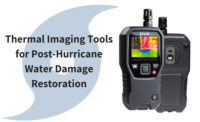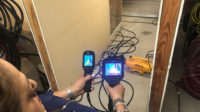R&R Q&A
Continuing to Innovate: Thermal Imaging for Water Damage Restoration

Editor’s Note:
This issue of R&R is chock full of trends and industry analysis. While you can read a whole lot more on the state of the restoration industry as a whole on page 9, this interview takes a deep dive into the topic of thermal imaging. According to R&R’s 2018 State of the Industry study, half of all restoration companies use thermal imaging for water damage restoration jobs, and almost 30 percent of companies plan to purchase more of them in the next 12 months. This is certainly an industry tool that continues to evolve, as FLIR’s Director of Marketing, Richard Wexler, explains in this interview. Enjoy!
What benefits do IR cameras bring to restoration contractors?
“It comes down to credibility. Obviously, the world is always increasing technology. Going into a job with this technology helps the contractor build credibility with their customer. They aren’t just depending on someone’s word; they are getting visible evidence of the problem. Plus, they can trace back to where the real problem is, which also translates into more work for the contractor by finding the source.”
What is the biggest misconception about thermal imaging?
“People believe there is a barrier to entry level; that it costs a fortune to get IR technology. You can spend $300 to get into this technology that will help you analyze a situation faster. In this industry, especially, IR allows contractors to really investigate if there are problems beneath the surface. Thermal imaging allows you to focus in and really get to that problem instead of searching more blindly for the issue.”

What are some of the more recent innovations with thermal imaging/IR technology?
“In September, FLIR introduced the FLIR ONE PRO LT. We wanted to make IR cameras more accessible to professionals to help them with their trades. So, the Thermal Pro LT brings infrared technology into your smartphone. It detects things, using your mobile device, that are not visible to the eye. To the naked eye, it looks fine, but to uncover that with thermal imaging and find where the problem lies is helpful.

“Every time you take a picture with the app open, it’s taking a visual picture and a thermal image. One image can lay on the other, which gives you some situational awareness. You can also the ability to take videos, which can include voiceover. Plus, there is Vivid IR, which gives you sharper images and more clarity. The clarity you will see out of the project is just phenomenal.”

Learning a new technology, whether it be software or a tool, can be overwhelming. What is the learning curve like with this technology?
“We tried to create an app that allows someone to use thermal imaging whether they are a seasoned pro or a newcomer. You have the ability to just instantly start up, point, and shoot. It is very easy to snap photos, and show hot and cold spots – from white hot, to a deep blue cold. From there, it is good to use a moisture meter – pin or pinless – to determine of moisture is present. Normally, in the buildings you’re looking for cold spots, possibly indicating water infiltration. Water tries to find the path of least resistance, so you can follow the entire path of the water. You don’t want to just fix the one wall, you want to find where the water came from.

What tips would you give restorers when shopping for a thermal imaging device?
1. “Make sure you have a product that allows you to have ease of use into the marketplace. Not a giant learning curve.”

2. “Make sure there is the right thermal sensitivity. There are lots of cameras out there; the more sensitive, the more you’re seeing really minute problems. Especially on the restoration side, you really can’t see minute water leaks (aka temperature differences) unless you have greater thermal sensitivity to allow the tool to work for you.”

Looking for a reprint of this article?
From high-res PDFs to custom plaques, order your copy today!







